Path Planning Algorithm of Orchard Fertilization Robot Based on Multi-Constrained Bessel Curve
Abstract
1. Introduction
2. Materials and Methods
2.1. A* Algorithm
2.2. Improved A* Full Coverage Path Planning Algorithm
2.3. Improved A* Path Planning Algorithm Based on Multi-Constrained Bessel Curve
2.3.1. Kinematic Model of Differential Steering Fertilization Robot Was Established
2.3.2. Bessel Curve
2.3.3. Bessel Curve Smoothing under Multiple Constraints
- (1)
- Curvature continuity constraint. Continuous curvature constraint is the key to ensure smooth turning of fertilizer robot. Curvature continuity requires the curvature changes of adjacent path segments on the path to be continuous, which can avoid the instability phenomena such as drastic turns in the tracking process of the fertilizer robot. According to the nature of the third-order Bessel curve, its second derivative is continuous, which can ensure that the trajectory planned at the turning point meets the curvature continuity constraints.
- (2)
- Slope continuity constraint. In order to smooth the global path, it is necessary to ensure the slope continuity at the connection between the Bezier curve and the straight line, so it is necessary to ensure the continuity of the first derivative at the connection of the curve. Taking the derivative of the connection between the Bezier curve and the straight line, substituting = 0 and =1, respectively (i.e., the start and end times of the Bezier curve), so that the two are equal, the junction of the third-order Bezier curve can be smooth.
- (3)
- Constraints on turning radius of fertilizer robot. The turning radius constraint ensures that any part of the trajectory curve has the practical feasibility that the robot can track, and the curvature of any point on the trajectory should be less than the reciprocal of the minimum turning radius of the robot, as shown below
3. Results
3.1. Simulation Analysis
3.1.1. Static Simulation of Improved A* Algorithm Based on Multi-Constrained Bessel Curve
3.1.2. Dynamic Simulation of Improved A* Algorithm Based on Multi-Constrained Bessel Curve
3.2. Real Machine Test
3.2.1. Test Platform
3.2.2. Experimental Design
4. Conclusions
5. Discussion
Author Contributions
Funding
Institutional Review Board Statement
Data Availability Statement
Conflicts of Interest
References
- Fu, Q.; Mei, J.; Li, L.; Wang, J.; Wang, H. Design of Intelligent Level Switch for Water and Fertilizer Integrated Intelligent Control Equipment. Trans. Chin. Soc. Agric. Mach. 2015, 46 (Suppl. S1), 108–115. [Google Scholar]
- Sang, Y.; Chen, X.; Chen, Q.; Tao, J.; Fan, Y. A route planning for oil sample transportation based on improved A* algorithm. Sci. Rep. 2023, 13, 22041. [Google Scholar] [CrossRef] [PubMed]
- Cai, B.; Li, M.; Yang, H.; Wang, C.; Chen, Y. State of Charge Estimation of Lithium-Ion Battery Based on Back Propagation Neural Network and AdaBoost Algorithm. Energies 2023, 16, 7824. [Google Scholar] [CrossRef]
- Li, J.; Yu, C.; Zhang, Z.; Sheng, Z.; Yan, Z.; Wu, X.; Zhou, W.; Xie, Y.; Huang, J. Improved A-Star Path Planning Algorithm in Obstacle Avoidance for the Fixed-Wing Aircraft. Electronics 2023, 12, 5047. [Google Scholar] [CrossRef]
- Feng, Y.; Zhang, W.; Zhu, J. Application of an Improved A* Algorithm for the Path Analysis of Urban Multi-Type Transportation Systems. Appl. Sci. 2023, 13, 13090. [Google Scholar] [CrossRef]
- Zhang, M.; Li, X.; Wang, L.; Jin, L.; Wang, S. A Path Planning System for Orchard Mower Based on Improved A* Algorithm. Agronomy 2024, 14, 391. [Google Scholar] [CrossRef]
- Liao, T.; Chen, F.; Wu, Y.; Zeng, H.; Ouyang, S.; Guan, J. Research on Path Planning with the Integration of Adaptive A-Star Algorithm and Improved Dynamic Window Approach. Electronics 2024, 13, 455. [Google Scholar] [CrossRef]
- Zhu, J.; Li, J.; Li, J.; Zhang, Z. Path planning of POL-Robot based on improved A* algorithm. Mech. Electr. Eng. Technol. 2022, 51, 1–5. [Google Scholar]
- Wang, Z.; Chen, X. Unmanned boat path planning algorithm based on improved, A*. DWA J. Sens. Technol. 2021, 34, 249–254. [Google Scholar]
- Gino, G.; David, F.; Nazik, Ö.; Liakopoulos, S.; Papanastassiou, D.; Faranda, C. Quaternary E-W Extension Uplifts Kythira Island and Segments the Hellenic Arc. Tectonics 2022, 41, e2022TC007231. [Google Scholar]
- Song, J.; Wu, J.; Wang, X.; Duan, Z.; Wang, X.; Lu, S. Accurate classification of power quality disturbance based on 3D visualized spiral curve and hybrid ER-MVCNN model. Measurement 2024, 231, 114654. [Google Scholar] [CrossRef]
- Gómez-Bravo, F.; Cuesta, F.; Ollero, A.; Viguria, A. Continuous curvature path generation based on β-spline curves for parking manoeuvres. Robot. Auton. Syst. 2008, 56, 360–372. [Google Scholar] [CrossRef]
- Li, J.; Liu, C. Smoothing Connected Bezier Curves and Surfaces through Optimal Adjustment of the Control Points. IAENG Int. J. Comput. Sci. 2023, 50, 1098–1107. [Google Scholar]
- Zhihao, Z.; Xiaodong, L.; Boyu, F. Research on obstacle avoidance path planning of UAV in complex environments based on improved Bézier curve. Sci. Rep. 2023, 13, 16453. [Google Scholar]
- Chojnacki, B.; Schynol, K.; Halek, M.; Muniak, A. Sustainable Perforated Acoustic Wooden Panels Designed Using Third-Degree-of-Freedom Bezier Curves with Broadband Sound Absorption Coefficients. Materials 2023, 16, 6089. [Google Scholar] [CrossRef] [PubMed]
- Takafumi, S.; Norimasa, Y. Curvature monotonicity evaluation functions on rational Bézier curves. Comput. Graph. 2023, 114, 219–228. [Google Scholar]
- Choi, J.W.; Curry, R.E.; Elkaim, G.H. Curvature-continuous trajectory generation with corridor constraint for autonomous ground vehicles. In Proceedings of the 49th IEEE Conference on Decision and Control (CDC), Atlanta, GA, USA, 15–17 December 2010; IEEE: Piscataway, NJ, USA, 2010; pp. 7166–7171. [Google Scholar]
- Zhao, W.; Zhou, D. Improved path planning algorithm based on A* and third-order Bézier curve fusion. J. Anhui Univ. Technol. (Nat. Sci. Ed.) 2023, 40, 333–338. [Google Scholar]
- Lu, E.; Lin, W.; Liu, Y. Research on intelligent forklift pallet picking path planning based on B-spline curves. Trans. Chin. Soc. Agric. Mach. 2019, 50, 394–402. [Google Scholar]
- Zhang, W.; Liu, Y.; Zhang, C.; Zhang, L.; Xia, Y. Real-time path planning for greenhouse robots based on directional A* algorithm. Trans. Chin. Soc. Agric. Mach. 2017, 48, 22–28. [Google Scholar]
- Shen, Y.; Liu, Z.; Liu, H.; Du, W. Path planning method for orchard spray Robot based on Multiple Constraints. Trans. Chin. Soc. Agric. Mach. 2023, 54, 56–67. [Google Scholar]
- Sun, W.; Tang, G.; Hauser, K. Fast UAV trajectory optimization using bilevel optimization with analytical gradients. In Proceedings of the 2020 American Control Conference (ACC), Denver, CO, USA, 1–3 July 2020; IEEE: Piscataway, NJ, USA, 2020; pp. 82–87. [Google Scholar]
- Yang, F.; Li, W.; Yan, T.-H. Path planning Algorithm of Mobile Robot based on gradient Optimization. Mod. Electron. Tech. 2019, 46, 99–104. [Google Scholar]
- Fue, K.; Porter, W.; Barnes, E.; Li, C.; Rains, G. Autonomous Navigation of a Center-Articulated and Hydrostatic Transmission Rover using a Modified Pure Pursuit Algorithm in a Cotton Field. Sensors 2020, 20, 4412. [Google Scholar] [CrossRef] [PubMed]
- Wu, G.; Wang, G.; Bi, Q.; Wang, Y.; Fang, Y.; Guo, G.; Qu, W. Research on unmanned electric shovel autonomous driving path tracking control based on improved pure tracking and fuzzy control. J. Field Robot. 2023, 40, 1739–1753. [Google Scholar] [CrossRef]
- Wei, Y.; Li, H.; Zhou, Z.; Chen, D. Driving Path Tracking Strategy of Humanoid Robot Based on Improved Pure Tracking Algorithm. IAENG Int. J. Appl. Math. 2024, 54, 286–297. [Google Scholar]
- Kayacan, E.; Ramon, H.; Saeys, W. Towards agrobots: Identification of the yaw dynamics and trajectory tracking of an autonomous tractor. Comput. Electron. Agric. 2015, 115, 78–87. [Google Scholar] [CrossRef]
- Bai, W.; Cao, Q.; Wang, P.; Chen, P.; Leng, C.; Pan, T. Modular design of a teleoperated robotic control system for laparoscopic minimally invasive surgery based on ROS and RT-Middleware. Ind. Robot. 2017, 44, 596–608. [Google Scholar] [CrossRef]
- MathWorks. MathWorks Introduces Robotics System Toolbox for Complete Integration with Robot Operating System ROS, Version 2015a; Biotech Business Week; MathWorks: Natick, MA, USA, 2015. [Google Scholar]

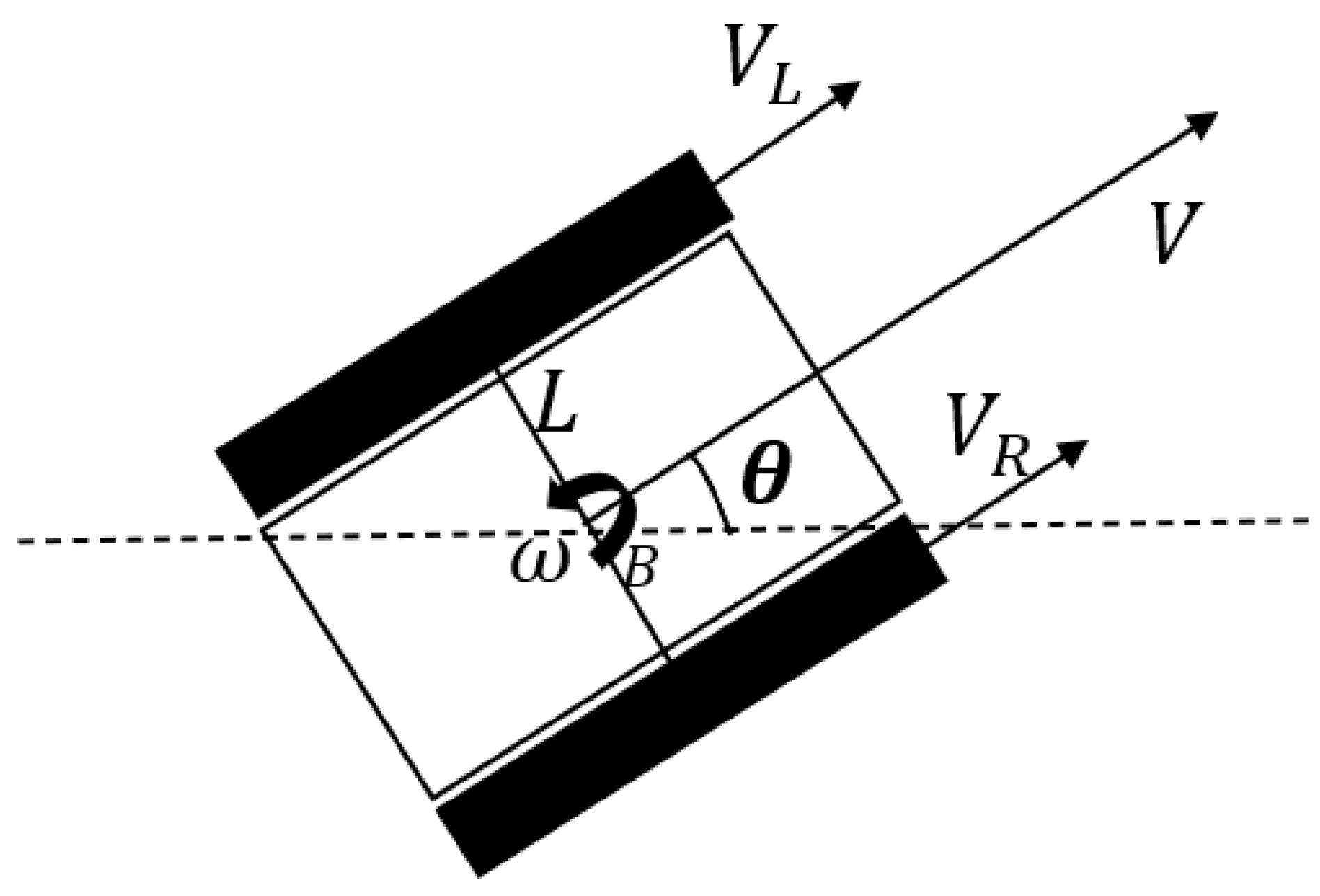
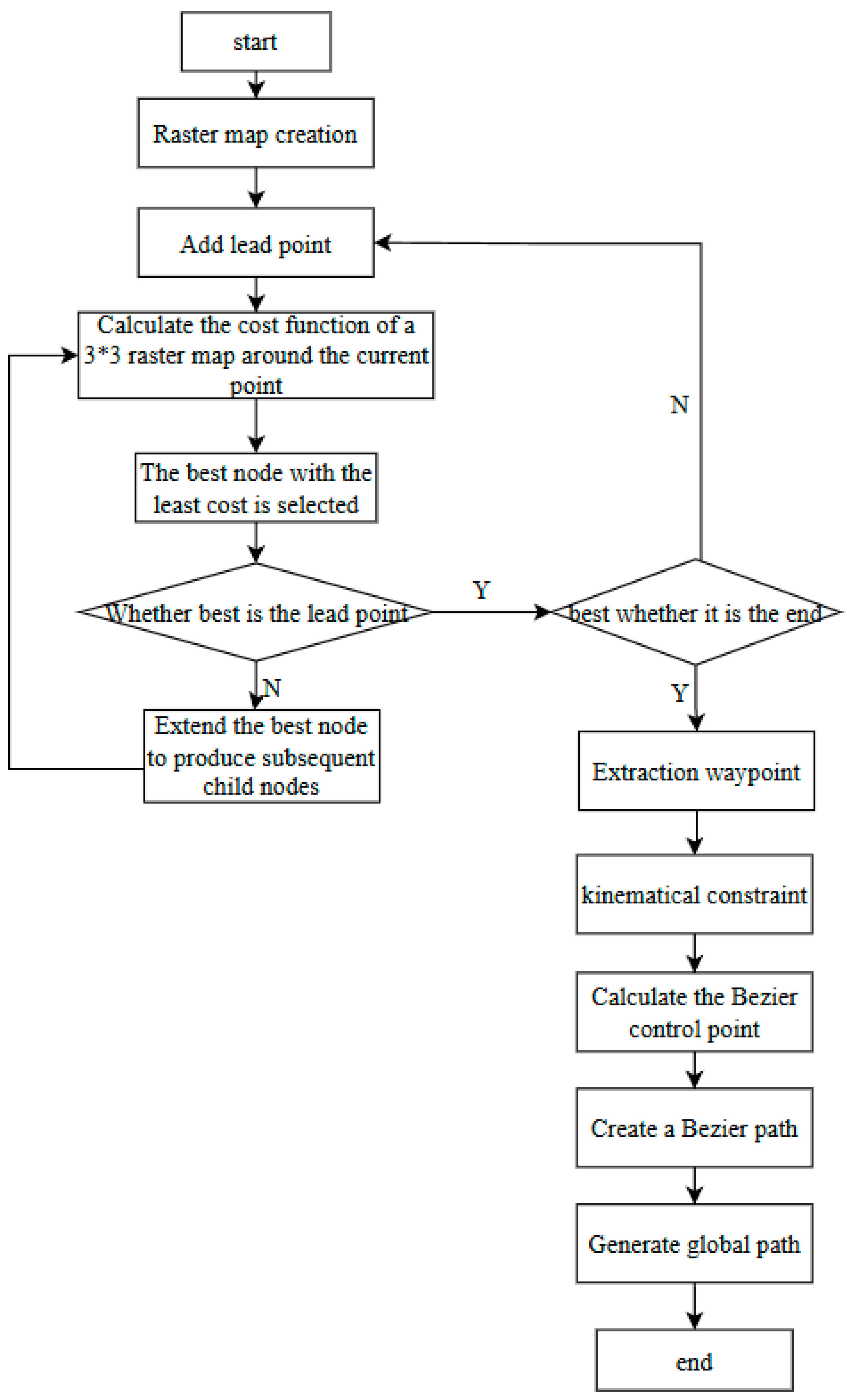

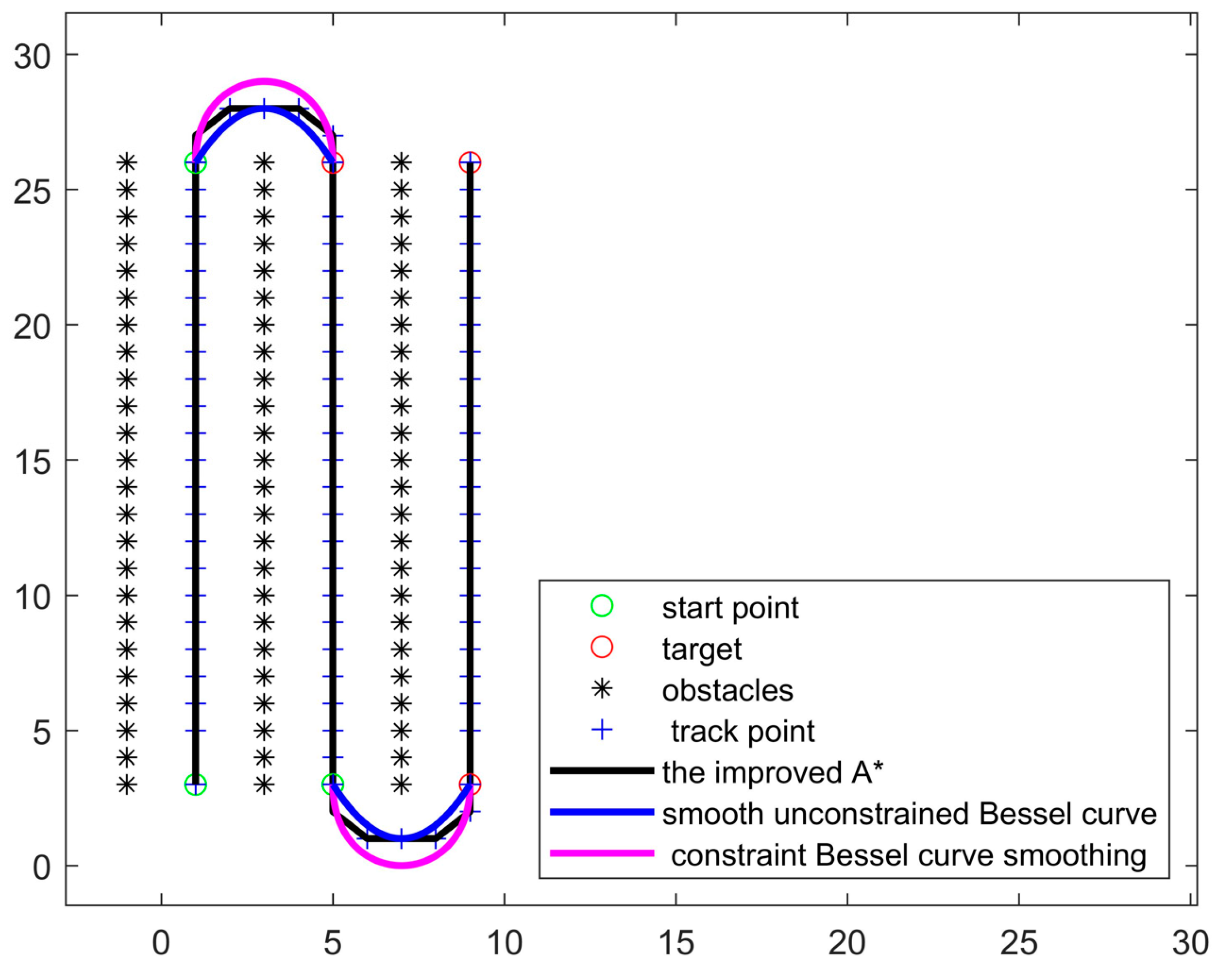
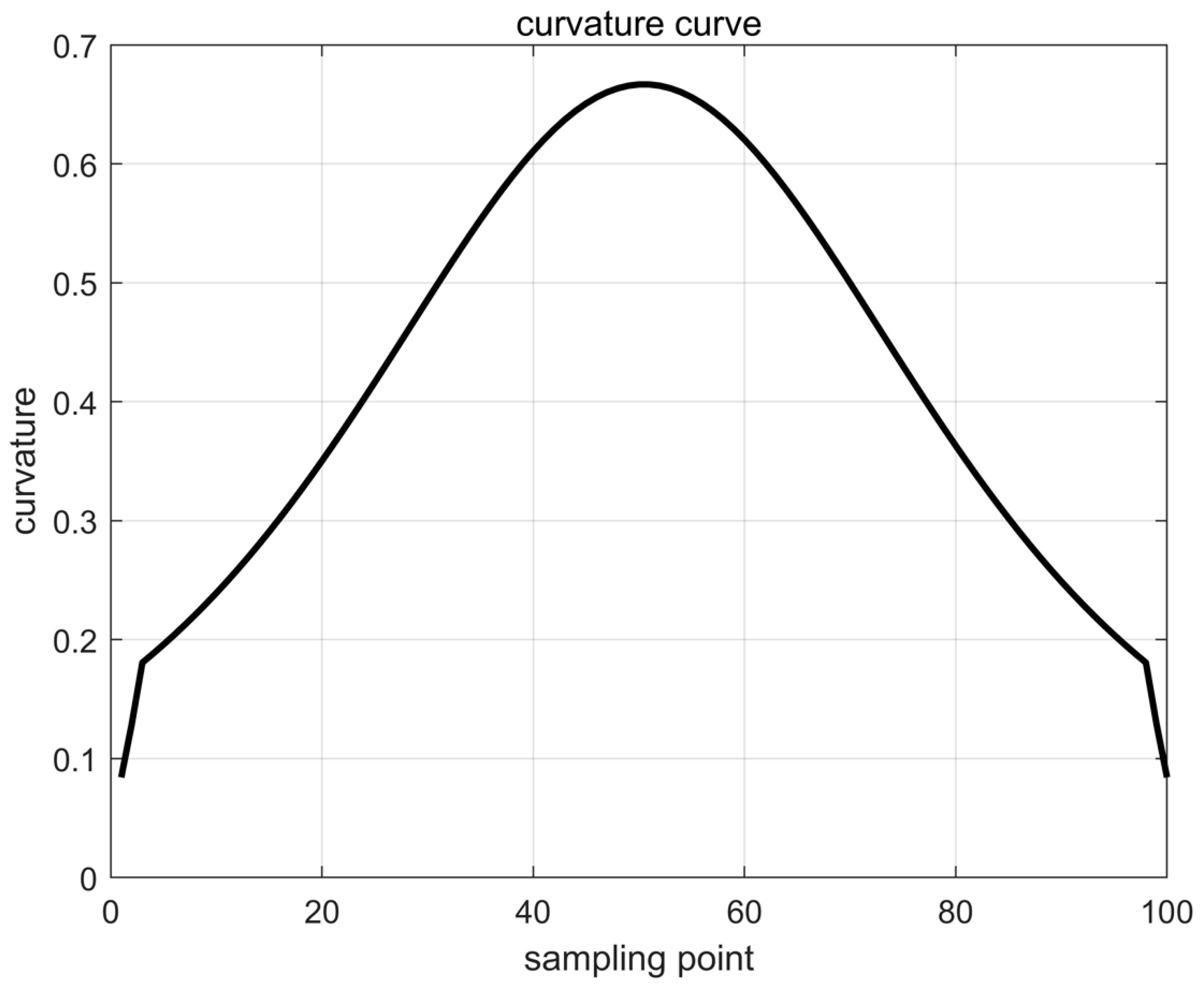

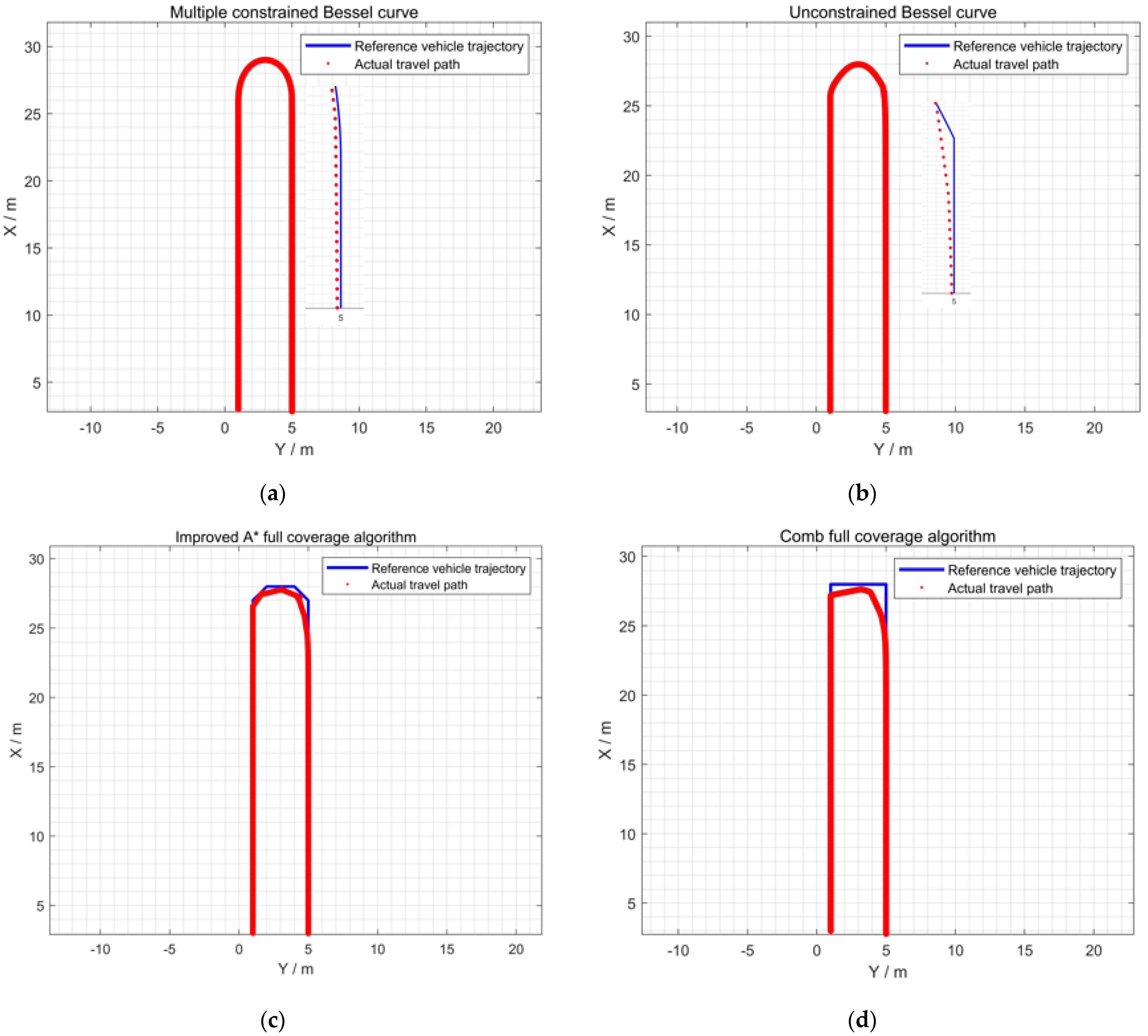

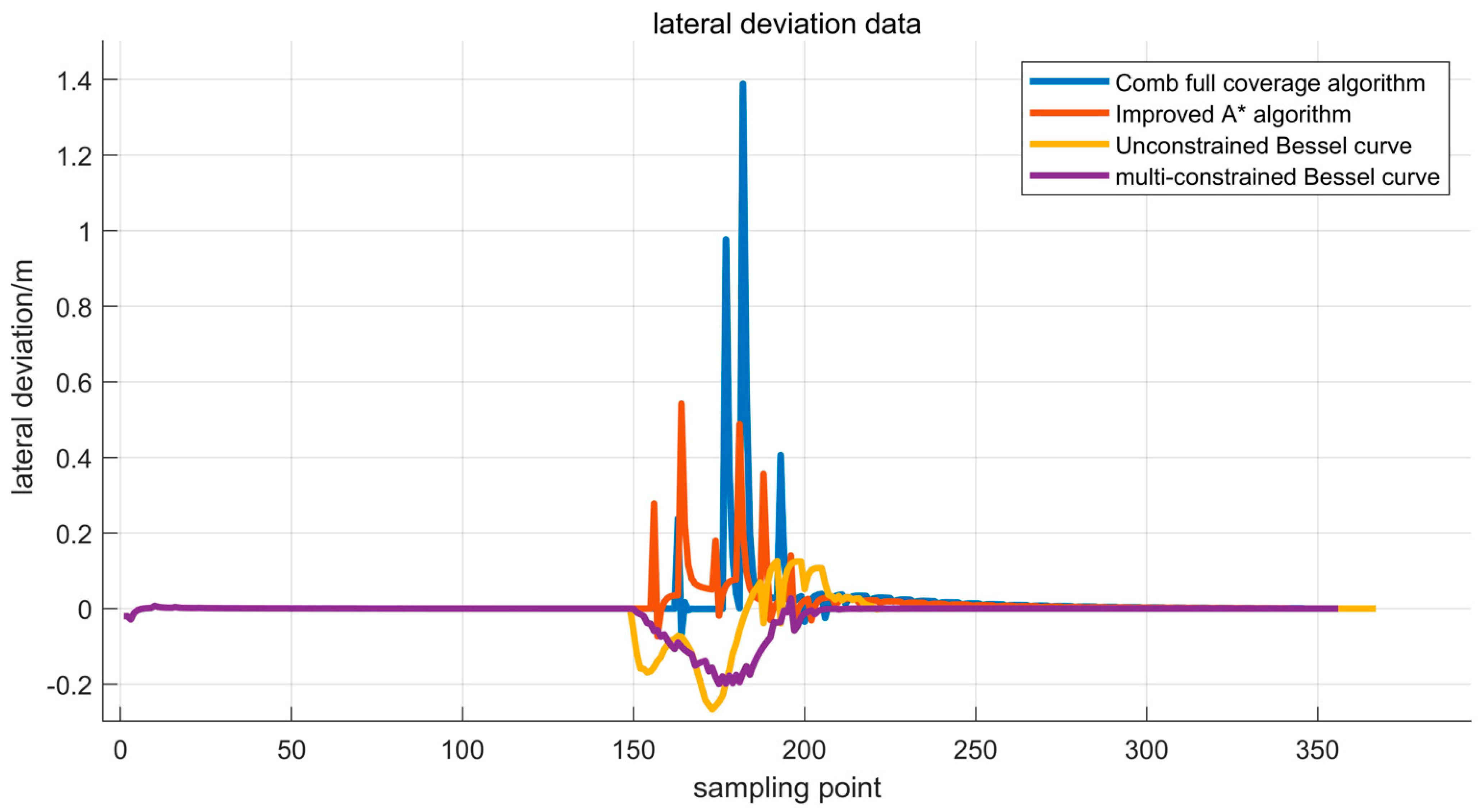
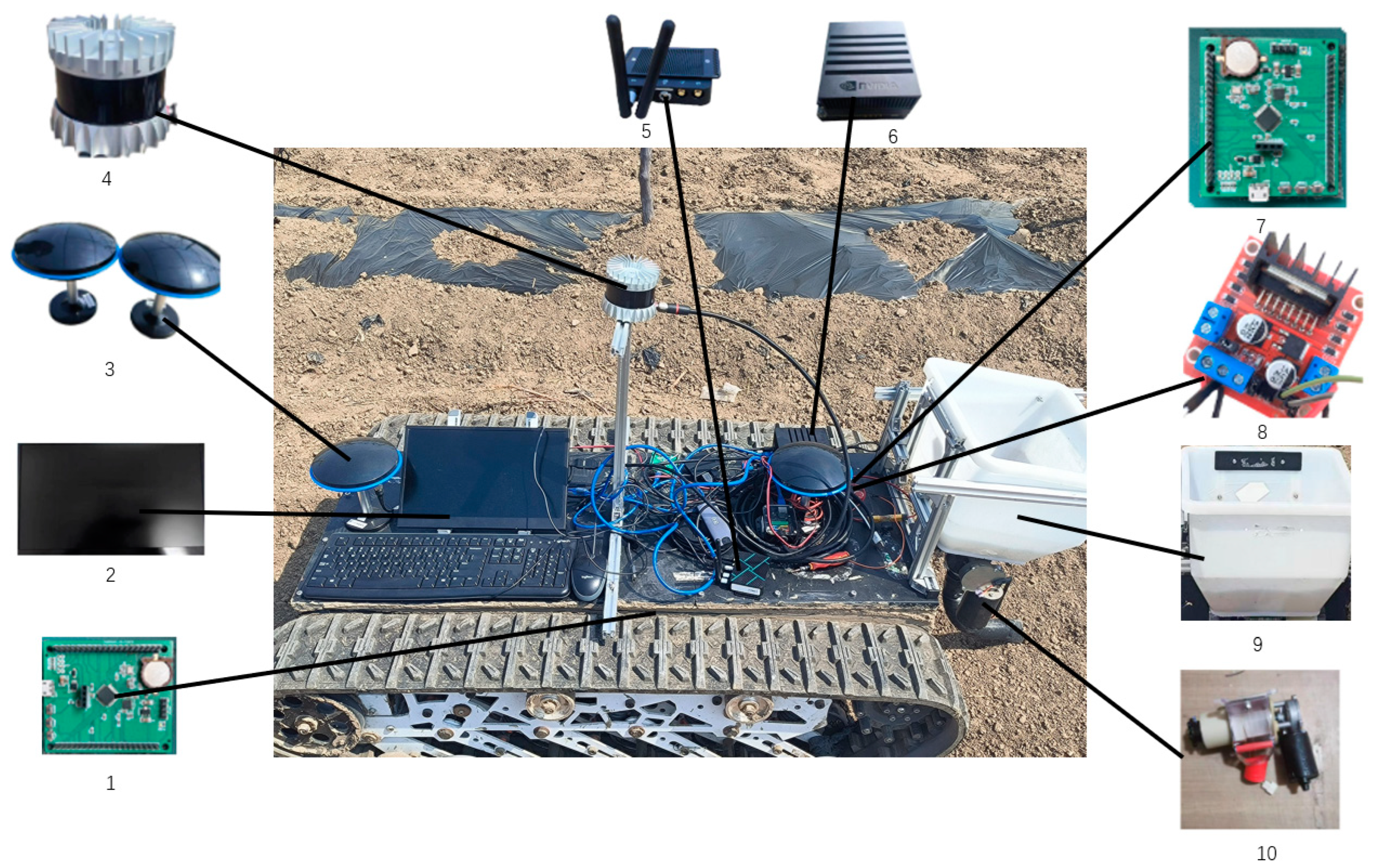

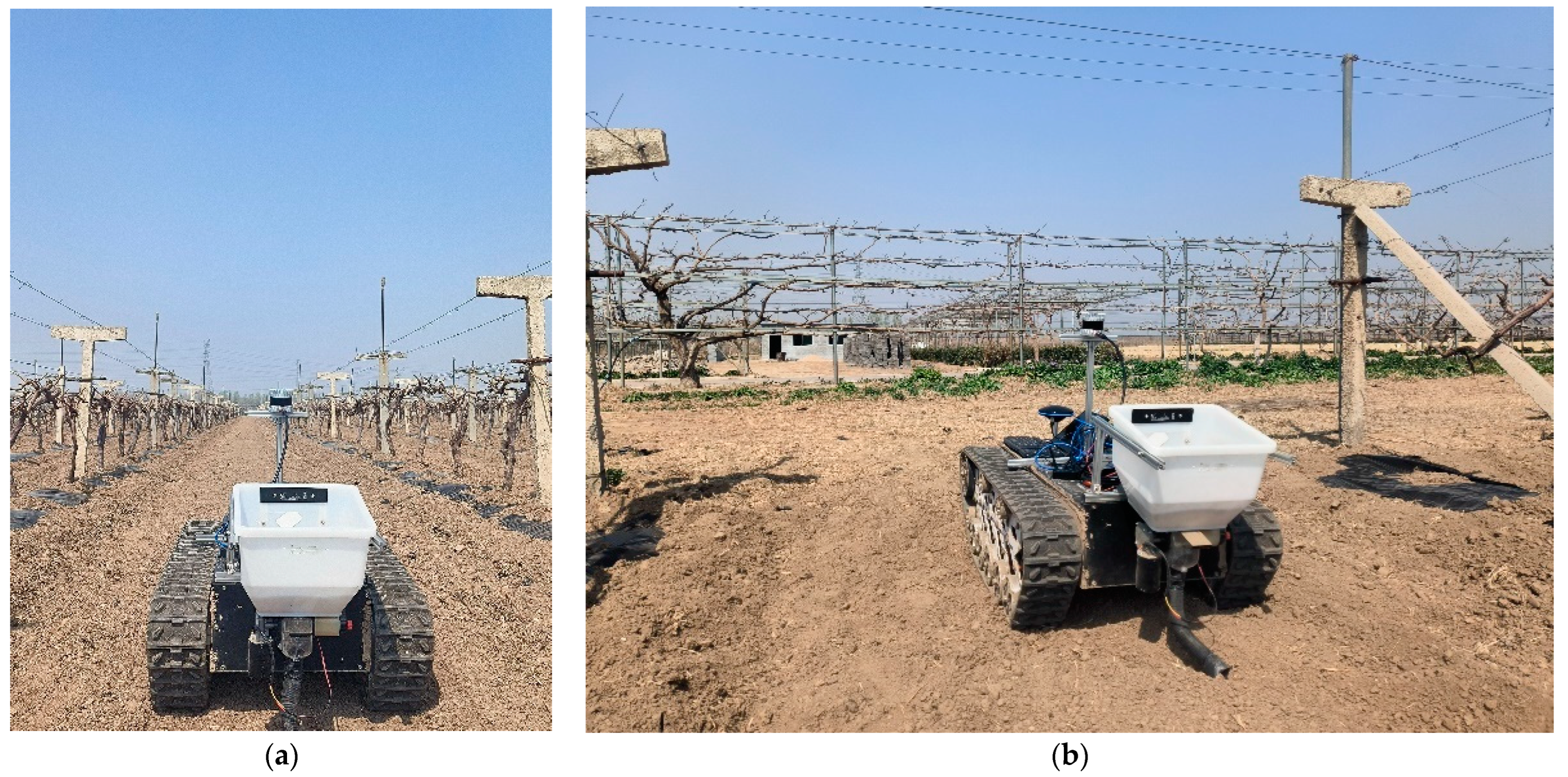
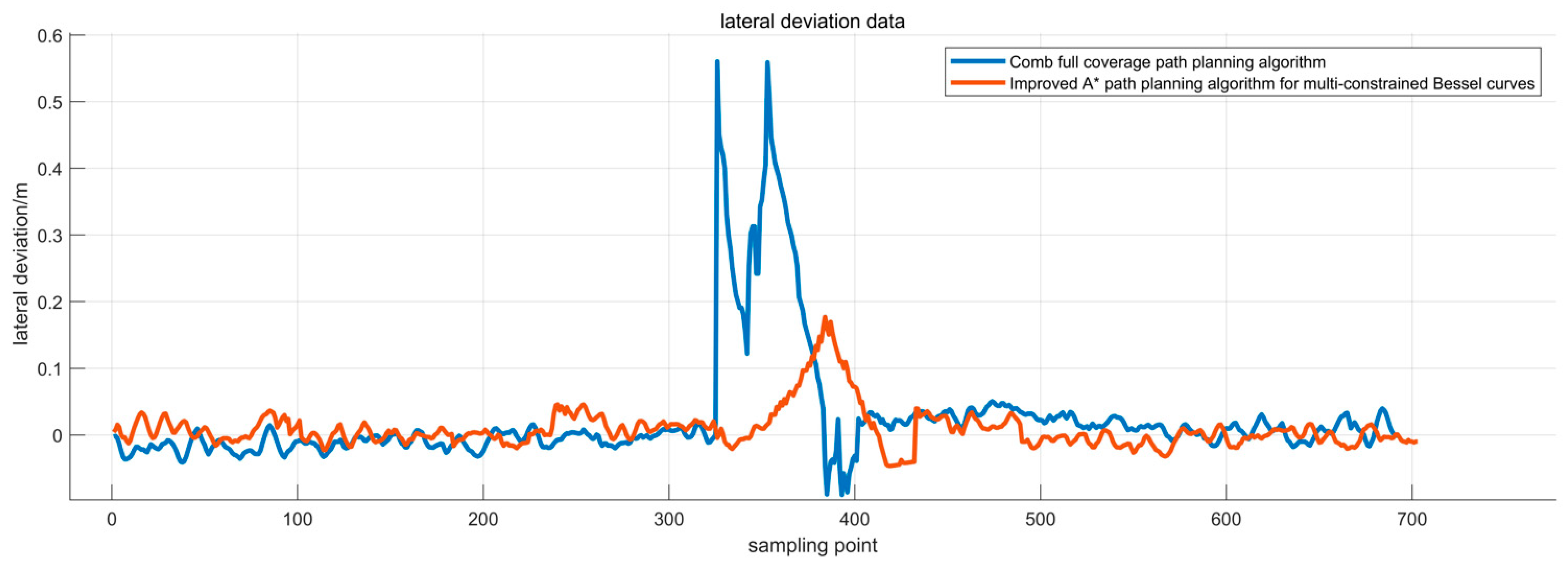

| Trajectory Tracking Algorithm | Mean Lateral Deviation/m | Maximum Lateral Deviation/m |
| Comb full coverage algorithm | 0.0299 m | 1.389 m |
| A* algorithm | 0.0198 m | 0.5422 m |
| Unconstrained Bessel curve | 0.0177 m | 0.2668 m |
| Multiple constrained Bessel curve | 0.0148 m | 0.1997 m |
| Path Planning | Test Path | Mean Lateral Deviation/m | Maximum Lateral Deviation/m |
|---|---|---|---|
| Comb full cover path planning | Straight path | 0.0162 m | 0.0505 m |
| U-turn path | 0.2580 m | 0.56 m | |
| Global path | 0.0388 m | 0.56 m | |
| Improved A* path planning for multi-constrained Bessel curves | Straight path | 0.0157 m | 0.0457 m |
| U-turn path | 0.1081 m | 0.1768 m | |
| Global path | 0.0185 m | 0.1768 m |
Disclaimer/Publisher’s Note: The statements, opinions and data contained in all publications are solely those of the individual author(s) and contributor(s) and not of MDPI and/or the editor(s). MDPI and/or the editor(s) disclaim responsibility for any injury to people or property resulting from any ideas, methods, instructions or products referred to in the content. |
© 2024 by the authors. Licensee MDPI, Basel, Switzerland. This article is an open access article distributed under the terms and conditions of the Creative Commons Attribution (CC BY) license (https://creativecommons.org/licenses/by/4.0/).
Share and Cite
Kong, F.; Liu, B.; Han, X.; Yi, L.; Sun, H.; Liu, J.; Liu, L.; Lan, Y. Path Planning Algorithm of Orchard Fertilization Robot Based on Multi-Constrained Bessel Curve. Agriculture 2024, 14, 979. https://doi.org/10.3390/agriculture14070979
Kong F, Liu B, Han X, Yi L, Sun H, Liu J, Liu L, Lan Y. Path Planning Algorithm of Orchard Fertilization Robot Based on Multi-Constrained Bessel Curve. Agriculture. 2024; 14(7):979. https://doi.org/10.3390/agriculture14070979
Chicago/Turabian StyleKong, Fanxia, Baixu Liu, Xin Han, Lili Yi, Haozheng Sun, Jie Liu, Lei Liu, and Yubin Lan. 2024. "Path Planning Algorithm of Orchard Fertilization Robot Based on Multi-Constrained Bessel Curve" Agriculture 14, no. 7: 979. https://doi.org/10.3390/agriculture14070979
APA StyleKong, F., Liu, B., Han, X., Yi, L., Sun, H., Liu, J., Liu, L., & Lan, Y. (2024). Path Planning Algorithm of Orchard Fertilization Robot Based on Multi-Constrained Bessel Curve. Agriculture, 14(7), 979. https://doi.org/10.3390/agriculture14070979





